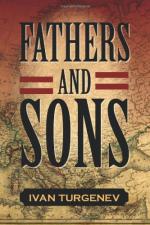|
This section contains 230 words (approx. 1 page at 400 words per page) |

|
Fathers and Sons Summary & Study Guide Description
Fathers and Sons Summary & Study Guide includes comprehensive information and analysis to help you understand the book. This study guide contains the following sections:
This detailed literature summary also contains Bibliography and a Free Quiz on Fathers and Sons by Ivan Turgenev.
Ivan Turgenev's Fathers and Sons was originally published in 1862 in the Russian magazine, Russkii vestnik (The Russian Herald), under the title, Ottsy i deti, and is also known as Fathers and Children in some translations. Even before its publication, the novel ignited controversy. The generation gap between the fathers and sons in the story neatly symbolized the current political debates between the older reactionaries and the younger radicals. The character of Bazarov, a young radical who declares himself a "nihilist," somebody who accepts nothingness, particularly inflamed both sides. Although Turgenev claimed at one point that he meant the book to be a favorable depiction of the young radicals, this group viewed Bazarov as a spiteful caricature of them. Many of the older liberals did not understand the book and were also very upset at the influence that it had on the young radicals, who claimed the term "nihilist" for themselves, and used it in their violent protests.
Despite the initially scathing reviews, the book has stood the test of time, and many regard it as Turgenev's best. The book also represents the times, depicting the social unrest that was present in Russia just prior to the historic 1861 emancipation of the serfs—Russian slaves that were owned by the landed nobility—by Alexander II, as well as the various reforms that were in place at the time.
Read more from the Study Guide
|
This section contains 230 words (approx. 1 page at 400 words per page) |

|



